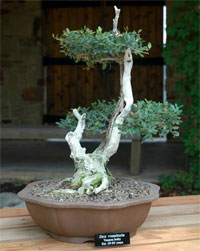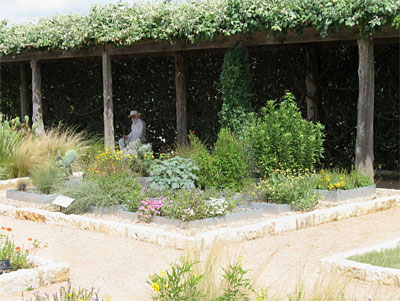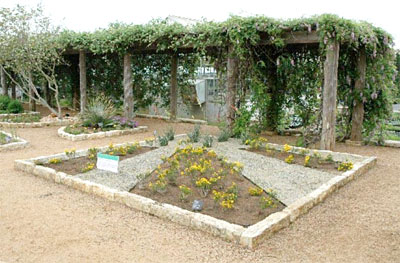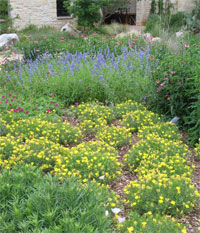Wild About Texas – November, 2009
Native Gardens of Many Styles

Yaupon holly bonsai. All photos by Andrea DeLong-Amaya.
When non-native gardens look bad, we blame the gardener. When a native garden looks bad, “those native weeds” get the blame. While unfair, this double standard is a reality with which native gardens must contend.
Historically, native plants have been used almost exclusively in naturalistic designs, appealing to those of us who enjoy less formal settings. However, our culture recognizes gardens that look intentional. How many times have I been asked by visitors halfway through the Lady Bird Johnson Wildflower Center tour, “Where are the gardens?” Formal or stylized gardens are all about intentionality. Naturalistic gardens, whether regarded as beautiful or not, often are not perceived as cultivated landscapes.
To touch a larger audience, the Wildflower Center has been exploring innovative ways to use natives, arranging them in unique patterns not necessarily found in nature. Perfect geometric shapes, symmetry, and strong, sharp lines are overlaid on the hard and soft scape. And various natives, just as well as exotics, have lent themselves to the tortures and contortions of bonsai, pollarding, espalier, and topiary.
In collaboration with the Austin Bonsai Society a couple of summers ago, we amazed visitors with an exhibit of 15 native bonsai crafted from yaupon holly, mustang grape, cedar elm, and other species. (Keep an eye out for our next bonsai exhibit this coming spring.)

Botanist’s Bed
The Botanists Bed, showcasing plants named after important Texas plantsmen, and the mirrored pair of Sunray Beds all have metal edging to delineate crisp linear forms. One of our Homeowner Inspiration Gardens incorporates a number of design techniques such as clearly defined borders, symmetry, geometric shapes, and a short species list to define formality in the space.

New plantings in the Sunray Bed

Café Meadow
We recently reworked our Café Meadow, which had become a farrago of species over many years. Imitating how wild plant populations often grow in patches, we now have consolidated plants into “mini monocultures,” making it easier for visitors to appreciate the overall character of each species. And the higher level of organization has allowed for even more varieties than were originally there. While retaining a naturalistic feel, the space now reads as a garden.
But whether or not a planting is viewed as a garden is less important than having it appreciated simply for its beauty, so maintenance is just as important to the success of a design as is the drawing. We’ve “tidied up” our less formal plantings by, of course, removing “weeds” (i.e., plants in the wrong place) and trimming up plants along the edges of pathways –- all challenging tasks to keep up with! Depending on the look we are going for, we may use mulch to provide a finished, even backdrop to the plantings, although this doesn’t work well in areas where we want plants to reseed. Trimming plants apart from each other for definition, and shaping wayward sprigs and branches are also effective techniques we’ve used (without turning flowers and shrubs into tightly sheared hedges, although that can be nice in the right location, too).

Homeowner Inspiration Garden
For more information about Texas native plants, including more great photos in our image gallery, visit the Wildflower Center’s website at: www.wildflower.org.
About the author: Andrea DeLong-Amaya is the director of horticulture at the Lady Bird Johnson Wildflower Center in Austin.

